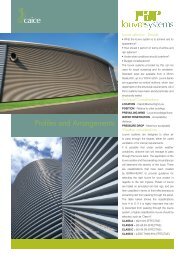CAICE Attenuator
CAICE Attenuator
CAICE Attenuator
Create successful ePaper yourself
Turn your PDF publications into a flip-book with our unique Google optimized e-Paper software.
<strong>Attenuator</strong> Performance<br />
Test Facility Layout and Components<br />
The test facility is essentially a closed loop ductwork system<br />
constructed from galvanised sheet steel, with a number of<br />
integral components. The main Test Duct sections A and B, are<br />
630mm diameter, and the total length of the loop is over 50m.<br />
<strong>Attenuator</strong> Test Assembly<br />
This consists of two transitions and the test object - which is<br />
either the test attenuator or an identically sized substitution duct,<br />
that replaces the attenuator.<br />
Sound Source and Test Duct A<br />
Random noise is generated by a speaker that is located within<br />
the sound source chamber. The modal filter exists to damp any<br />
higher order modes generated within the sound source chamber<br />
thus creating a plane wave sound field within Test Duct A.<br />
Pressure and temperature measurement stations are also<br />
located within this section.<br />
Test Duct B<br />
A microphone is automatically moved along a diagonal track<br />
within Test Duct B to measure the noise level in five different<br />
positions, which determines the average sound pressure level.<br />
An anechoic termination helps to reduce noise reflections back<br />
down the duct that could interfere with the noise measurements.<br />
Another pressure measurement station is located in this section.<br />
Auxiliary Fan and Volume Flow Measurement<br />
An auxiliary fan system is located within the ductwork loop to<br />
provide airflow up to 2m 3 /s.<br />
High performance primary and secondary attenuators are<br />
installed on both sides of the fan to minimise noise transmission<br />
to the microphone position.<br />
The fan can be rotated through 180 degrees, which enables air<br />
to be moved across the test object in either forward or reverse<br />
flow modes.<br />
The volume flow measurement section uses a Wilson Flow Grid<br />
to measure the airflow that is generated by the auxiliary fan.<br />
Further pressure and measurement stations are also located<br />
within this section.<br />
Test Data Acquisition<br />
All data is gathered at a control station and recorded using an inhouse<br />
software programme, which automatically produces a<br />
comprehensive <strong>Attenuator</strong> Test Report for each test object.<br />
<strong>Attenuator</strong> Performance Properties<br />
In order to explain attenuator performance properties, it is<br />
helpful to understand the basic testing procedures.<br />
The same test procedures must be carried out firstly on the<br />
attenuator itself and then secondly on an empty replacement or<br />
substitution duct. The substitution duct has exactly the same<br />
geometric properties as the test attenuator and both are referred<br />
to as the test object when under test.<br />
Static Insertion Loss<br />
This is determined by subtracting the noise levels measured with<br />
an attenuator installed from the noise levels measured with the<br />
substitution duct installed. It is referred to as static because<br />
there is no air passing through the test object.<br />
Dynamic Insertion Loss<br />
Again this is determined by subtracting the noise levels<br />
measured with an attenuator installed from the noise levels<br />
measured with the substitution duct installed. However it is<br />
referred to as dynamic as there is air passing through the test<br />
object.<br />
Dynamic insertion losses can be measured with either forward<br />
or reverse airflow across the test object, and with up to five<br />
different airflow rates for each direction.<br />
Flow Generated Sound Power Levels<br />
When air passes through an attenuator it generates noise. This<br />
is defined as attenuator flow generated noise, regenerated noise<br />
or self-noise.<br />
<strong>Attenuator</strong> flow generated sound power levels can be<br />
determined with either forward or reverse airflow across the test<br />
object, and again with up to five different airflow rates for each<br />
direction.<br />
Noise levels also need to be measured under the same<br />
conditions with the substitution duct installed to ensure that flow<br />
noise generated through the ductwork loop itself is not additive<br />
to the attenuator flow generated noise.<br />
Total Pressure Loss<br />
This is determined by subtracting the differential pressure across<br />
the attenuator from the differential pressure across the<br />
substitution duct.<br />
A total pressure loss coefficient is calculated for each attenuator<br />
by measuring the total pressure loss at five different airflow<br />
rates.<br />
36<br />
www.caice.co.uk<br />
<strong>CAICE</strong> <strong>Attenuator</strong> Brochure
















